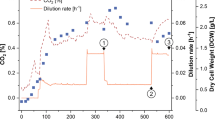Abstract
Clostridium pasteurianum total cellular saturated fatty acids increased through its growth cycle from 81% to 91% but varied significantly in the composition under nitrogen- and non-nitrogen-fixing conditions. During ammonia-assimilating growth, palmitic acid decreased from 67.7% to 43.5% by late log while marked increases in shorter chain saturated fatty acids (C15:0 and below) and a long chain saturated C22:0 occured. In contrast, under N2-fixing growth conditions, palmitic acid increased from 45.5% to 84.3% by late log, representing nearly the total amound of saturated fatty acids found inC. pasteurianum. The total cellular lipid concentration decreased as the culture aged. irrespective of the nitrogen sources; however, the phospholipid concentration increased significantly during N2-fixing growth as compared with a 50% decrease during ammonia-assimilating conditions. The implication of these differences and possible role of palmitic acid and phospholipids inC. pasteurianum nitrogen fixation process are discussed.
Similar content being viewed by others
Literature Cited
Able, K., Deschmertzing, H., Peterson, J. I. 1963. Classification of microorganisms by analysis of chemical composition. Journal of Bacteriology85:1039–1044.
Bligh, E. G., Dyer, W. J. 1959. A rapid method of total lipid extraction and purification. Canadian Journal of Biochemistry and Physiology37:911–917.
Ceuterick, P., Heremans, K., Smedt, H. 1977. Specific lipid requirement for the activation ofAzotobacter nitrogenase. Archives of International Physiology and Biochemistry85:394–395.
Chwang, W. K., Pawagi, A., Campbell, I. M. 1979. Changes on the osmotic behavior of phosphotidylcholine vesicles induced by interaction with polyaminoacids. Canadian Journal of Biochemistry57:302–304.
Cronan, J. E., Vagelos, P. R. 1972. Metabolism and function of the memrrane phospholipids ofE. coli. Biochimica et Biophysica Acta265:25–60.
Dittmer, J. C., Lester, R. L. 1964. A simple specific spray for the detection of phospholipids on thin-layer chromatograms. Journal of Lipid Research5:126–127.
Farrell, J., Rose, A. 1967. Temperature effects on micro-organisms. Annual Review of Microbiology21:101–120.
Heefner, D. L., Claus, G. W. 1976. Change in quantity of lipids and cell size during intracytoplasmic membrane formation inGlucanobacter oxydans. Journal of Bacteriology125:1163–1171.
Kleiner, D., Fitzke, E. 1979. Evidence for ammonia translocation byClostridium pasteurianum. Biochemical and Biophysical Research Communications86:211–217.
Laishley, E. J., Krouse, H. R. 1978. Stable isotope fractionation byClostridium pasteurianum. 2. Regulation of sulfite reductases by sulfure amino acids and their influence on sulfur isotope fractionation during SO32− and SO42− reduction. Canadian Journal of Microbiology24:716–724.
MacKenzie, S. L., Lapp, M. S., Child, J.J. 1979. Fatty acid composition ofRhizobium spp. Canadian Journal of Microbiology25:68–74.
Moss, C. W., Lewis, V. J. 1967. Characterization of clostridia by gas chromatography. Applied Microbiology15:390–397.
Su, C. J., Reusch, R., Sadoff, H. C. 1979. Fatty acids in phospholipids of cells, cysts and germinating cysts ofAzotobacter vinelandii. Journal of Bacteriology137:1434–1436.
Weeks, G., Wakil, S. J. 1970. Studies on the control of fatty acid metabolism. Journal of Biological Chemistry245:1913–1921.
Wells, M. A., Dittmer, J. C. 1963. The use of Sephadex for the removal of nonlipid contaminnts from lipid extracts. Biochemistry2:2159–2163.
Winter, H. C., Burris, R. H. 1976. Nitrogenase. Annual Review of Biochemistry45:409–426.
Author information
Authors and Affiliations
Rights and permissions
About this article
Cite this article
Deo, Y.M., Bryant, R.D. & Laishley, E.J. Differences in cellular fatty acids and lipid composition inClostridium pasteurianum under nitrogen-and non-nitrogen-fixing conditions. Current Microbiology 3, 55–58 (1979). https://doi.org/10.1007/BF02603135
Issue Date:
DOI: https://doi.org/10.1007/BF02603135




